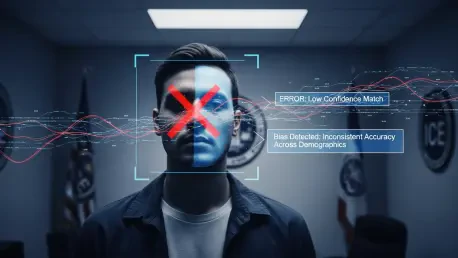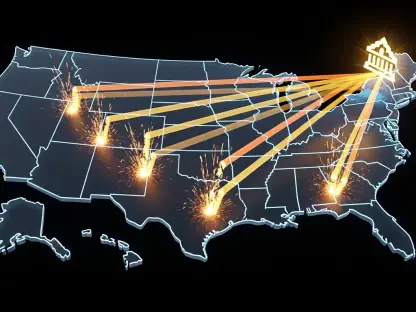In a troubling development that has sparked outrage among civil liberties advocates, Immigration and Customs Enforcement (ICE) in the United States has ramped up its use of facial recognition technology, raising serious concerns about privacy erosion and racial bias. Reports indicate that this technology, often deployed without consent, is disproportionately affecting Black and Brown communities, intensifying fears of a surveillance state that prioritizes control over justice. Senator Edward J. Markey has emerged as a vocal critic, warning that these practices threaten to transform public spaces into zones of constant monitoring, where individuals are tracked and targeted based on flawed algorithms. This issue sits at the intersection of immigration enforcement and advanced technology, highlighting a growing divide between security justifications and the fundamental rights of citizens and noncitizens alike. As these tools become more pervasive, the potential for systemic abuse looms large, demanding urgent scrutiny and action.
Surveillance Technology in Immigration Enforcement
Expanding Reach of Facial Recognition
The deployment of facial recognition by ICE has become a cornerstone of its enforcement strategy, but it comes with significant ethical and practical challenges. Senator Markey has described instances where agents, often masked to conceal their identities, photograph individuals without permission, using mobile applications like Mobile Fortify to scan faces against sprawling federal databases. These images are retained for up to 15 years, even when no match is found, creating a chilling repository of personal data. This practice not only invades privacy but also instills fear in communities of color, who are disproportionately targeted. The lack of transparency around how this data is stored or used further exacerbates concerns, as there is little accountability to prevent misuse. Experts argue that such unchecked power resembles dystopian surveillance tactics, designed more to intimidate than to protect, and the implications for civil liberties are profound as these technologies become embedded in everyday enforcement.
Beyond the immediate privacy violations, the reliability of facial recognition technology itself remains deeply flawed, particularly for non-white individuals. Studies have consistently shown higher rates of misidentification among Black and Brown faces, leading to wrongful targeting and potential arrests. When combined with ICE’s access to vast databases, including driver’s license photos covering a third of adult Americans, the risk of error becomes a systemic threat. Critics point out that these errors are not mere technical glitches but can result in devastating consequences for those misidentified, often without any recourse. The Department of Homeland Security (DHS), which oversees ICE, has offered scant details on safeguards or oversight mechanisms, leaving lawmakers and advocates frustrated. This opacity fuels the narrative that such technology serves as a tool for racial profiling rather than a neutral means of enforcement, amplifying calls for immediate reform to protect vulnerable populations from unjust scrutiny.
Invasive Tools Beyond Facial Scans
ICE’s surveillance arsenal extends far beyond facial recognition, incorporating other invasive technologies that further erode constitutional protections. Tools like Graphite, a spyware developed by Paragon Solutions, can infiltrate personal devices without user interaction, granting access to private communications and data. Legal experts, including Jeramie Scott from the Electronic Privacy Information Center, have labeled these capabilities as dangerously intrusive, violating rights enshrined in the Fourth Amendment. The deployment of such tools often occurs without public knowledge or consent, raising alarms about the potential for abuse in both immigration enforcement and broader policing contexts. As these technologies proliferate, the line between security measures and outright overreach blurs, leaving communities vulnerable to constant monitoring with little to no oversight from federal authorities.
Additionally, plans by DHS to expand biometric data collection add another layer of concern to an already contentious issue. Proposals include gathering facial images, iris scans, voice prints, and even DNA from noncitizens and their U.S. relatives, creating an unprecedented web of surveillance. Critics argue that this approach normalizes the treatment of personal identity as a commodity for government use, disregarding existing legal norms. Combined with ICE’s access to utility records that can locate three out of four adults, the scale of data collection suggests a deliberate effort to build a comprehensive tracking system. Privacy advocates warn that such measures, pushed aggressively under current policies, dismantle previous restraints and set a dangerous precedent for future administrations to exploit. The lack of bipartisan consensus on halting these practices only heightens the urgency for legislative intervention to curb these invasive tactics.
Civil Liberties and Racial Bias Concerns
Systemic Flaws and Disproportionate Impact
The intersection of facial recognition technology and racial bias forms a critical point of contention in the debate over ICE’s surveillance practices. The inherent flaws in these systems, which frequently misidentify people of color at higher rates than their white counterparts, exacerbate existing inequalities in enforcement. This technological bias, coupled with a historical pattern of targeting Black and Brown communities, creates a vicious cycle of unjust scrutiny and punishment. Senator Markey has emphasized that public spaces should not become arenas where faces are scanned and tracked as if they were barcodes, a sentiment echoed by many who see these tools as instruments of intimidation. Without robust checks and balances, the potential for systemic abuse grows, threatening the very fabric of democratic freedoms and disproportionately harming marginalized groups who already face significant barriers.
Moreover, the chilling effect of such surveillance on free speech and dissent cannot be overstated. Communities under constant watch are less likely to engage in protests or political activism, fearing retaliation or wrongful identification by flawed systems. Privacy experts like Emily Tucker from Georgetown Law’s Center on Privacy and Technology argue that immigration enforcement is being weaponized to construct a broader surveillance apparatus, one that could easily pivot to other forms of policing at the whim of those in power. The lack of transparency from ICE and DHS only deepens mistrust, as lawmakers struggle to obtain basic information about vendors or operational protocols. This secrecy, combined with an administration willing to push legal and ethical boundaries, underscores the urgent need for accountability measures to protect vulnerable populations from being silenced or unfairly targeted by these invasive technologies.
Path Forward for Accountability
Reflecting on the rapid expansion of ICE’s surveillance tools, it’s clear that past efforts to address these issues fell short of curbing the disproportionate impact on Black and Brown communities. The integration of facial recognition into routine enforcement, alongside plans for broader biometric data collection, paints a troubling picture of a surveillance state that prioritizes control over fairness. Critics, led by figures like Senator Markey, have repeatedly warned of the erosion of civil liberties, highlighting how these practices chill dissent and target marginalized groups with alarming precision. The lack of oversight from federal agencies during this period only compounds the problem, leaving fundamental rights at risk.
Looking ahead, the focus must shift to actionable reforms that restore trust and protect privacy. Establishing strict guidelines on the use of facial recognition and other invasive tools should be a priority, alongside mandatory transparency reports from ICE and DHS on data collection practices. Legislation to limit the retention of biometric data and ensure independent audits of these systems could mitigate risks of misidentification and bias. Furthermore, engaging community voices in shaping these policies will be crucial to addressing the unique challenges faced by those most affected. As technology continues to evolve, proactive measures to safeguard constitutional protections will remain essential to prevent the further entrenchment of discriminatory surveillance practices.









